How To Use A Flexibility Routine To Smash Through Your Performance Barriers
[vc_row][vc_column width=”1/1″][vc_column_text]
[/vc_column_text][/vc_column][/vc_row][vc_row][vc_column width=”1/1″][vc_column_text] Stretching before and after exercise can and will take your workout routine to the next level…but only when done right!
Stretching before and after exercise can and will take your workout routine to the next level…but only when done right!
But what is the right way?
And what’s the difference between static stretching and dynamic stretching?
We do a little calf stretch here, and the one where you hold your elbow across our body.
(What muscle’s that one stretching again?)
Now all of us have heard lots about the importance of grabbing some exercise – it makes us feel great.
But a lot of us do too, much too soon:
- We get injured
- We burn out
- And we end up waiting weeks to exercise again
What if by adding a simple 5 minute process to our workouts we could stop this from happening..?
Today I will show you the benefits of applying just a few simple steps to your workout, and how we can amp up your performance with just a few minutes before and after.
We will also cover the differences between these exercises on the floor or in an Antigravity® hammock, including which sports these are PERFECT for…
Struggling With Static Stretch Ideas? Try THIS GUIDE For How To Do A Perfect Down Dog
Get Ship Shape For Summer: Simple Stretches To Amp Your Performance, Speed Up Recovery And Rocket Blast Your Routines
Whether you are a runner, a surfer, a rock climber or netball player or simply just starting out in your fitness journey…
If you’re anything like me you have your plan mapped out in your head or on paper of up-and-coming training and “Summer goals”
You’re focused on:
- the marathon
- your target weight or
- the road-trips to days on the waves
But sometimes we can over-look how we are going to help our body recover as we push through and strive for the next level.
Flexibility and stretching is vital to promote proper recover and prevent injury.
So let’s dive in and get you performing at your peak! You may just learn something new as we explore our…
…Step #1: Flexibility Training And Fitness Goals
From personal experience I know that even a small amount of stretching can improve muscle condition and flexibility leading to better performance in life and on the track.
Even a little a day results in more efficient muscle contraction and a greater range of motion. But what does this mean for our exercise goals?
I’d love to share my experience with you to help take your health and fitness to the next level.
 Why Does It Matter To Me?
Why Does It Matter To Me?
We see it all too often that a motivated individual with the best intentions of reaching their goals falls short due to injury. We can’t always prevent injuries, but we can do our best to make sure we are training safely.
When we start a new training routine our body is under stress. As we ask more of our body (more weight, longer training) we begin to adapt by growing stronger.
If you don’t exercise often, it could mean that your muscles are de-conditioned, meaning they could need a helping hand to stay strong.
De-conditioned muscles can mean a lot of things, mainly that muscle fibers don’t contract as efficiently as someone who trains regularly.
This can lead to muscular imbalances in turn leading to injury, in turn saying “bye” to the marathon dreams.
The good news is that you can actively avoid injury by incorporating stretching into your workout and as rehabilitation from your usual training regime.
No matter your athletic ability – pro or just starting out – a good flexibility routine can bring help to bring you closer to your fitness goals.
How often and the methods you use to stretch are affected by what you’d like to achieve. If you are looking at stretching to reach your fitness goals faster, this is the article for you.
Please Note : Stretching for injury rehabilitation is very different, and we advise if you have an injury to always see a health professional.
Let’s look at some stretches you can implement into your own exercise routine.
Firstly though, let’s look at why stretching is key to maintaining a healthy body and where it can fit in with your overall fitness goals.
 Flexibility and where it fits into your fitness goals
Flexibility and where it fits into your fitness goals
There are three main components of fitness:
- Cardiovascular training (keeping the heart beating at a quicker pace for an extended amount of time) is vital for your heart and lung health, keeping them strong and efficiently
- Strength training is important for good posture and physical efficiency
- Flexibility training is key to peak performance, posture and physical efficiency
Simply put, optimum fitness can’t be achieved unless there is balance between the three components.
For Example:
If a marathon runner chose to neglect strength training, muscular imbalances in the core and legs could cause injury.
The same if a weight lifter only focused on strength training, they would quickly find they built a body with a reduced range of motion.
From personal experience, I know that a flexibility routine can help take your health and fitness to the next level.
Step 2# – Know Why You Need To Incorporate Flexibility Stretches To Your Weekly Schedule ASAP
So, we know flexibility training is important, so lets look at some benefits of stretching in detail.
In a health and fitness context, stretching is the relaxation and lengthening of a muscle. We can use this relaxation reflex to improve flexibility in a careful and controlled way.
 This gentle lengthening brings out responses in the body including:
This gentle lengthening brings out responses in the body including:
- A greater range of motion and injury prevention
- Improved posture
- Increasing blood flow moving toxins from the joint
- Burns calories
- Reduces Muscle soreness
- Aids in mental and physical relaxation
Read on to look at these in more detail…
A Greater Range Of Motion
When stretching, all the muscles, tendons and connective tissue are lengthened. Tight muscles are much more susceptible to to muscle strain putting you out of action!
Tight muscles can also lead to imbalances in the body’s alignment resulting in muscle strain.
Better Posture
Poor posture is caused by muscular imbalances and can really prevent your body working at optimal levels. If you sit at a desk, drive, even stand all day it is especially important to make sure your workout routine is balanced with a flexibility program that reduces these imbalances.
Increasing blood flow moving toxins from the joint
As you stretch, you encourage blood flow around the joint bringing vital nutrients to the muscle and tendon structures which may contribute to better function and elasticity.
As blood flow increases, your body can draw away toxins caused by inflammation and fatigue.
Burns Calories
Yes you can burn calories from stretching! Especially if you integrate one or two hour long sessions into your weekly routine.
Reduces Muscle Soreness from Exercise
Effective post workout stretching relieves the muscles you just worked. Blood flow and nutrient flow is increased reducing the effects of DOMS (delayed onset of muscle soreness)
Aids in Mental and Physical relaxation
Some stretching routines promote deep and effective breathing which helps clear the mind of negative thoughts. Moving the diaphragm during breath can clear stress hormones from the blood bringing an overall feeling of calm. Dr. Libby Weaver, renowned speaker, author and nutritionist supports this theory, and recommends diaphragmatic breathing as an important tool in living a stress-free life.
“Long, slow belly breathing expands the muscles in your diaphragm, expanding the lung’s air pockets, stimulating our relaxation response.”
Dr. Libby Weaver
(BHSc (N&D) (Hons) PhD)
Step #3 – Understand the Different Types of Stretching And When To Use Them In Your Routine
Great, so now we understand the benefits!
To begin to understand how and why we stretch lets look at the two different types of stretches and where they fit into your workout.
I’m not saying the stretch in the hammock will replace the stretch on the floor. In fact, they compliment each other !
Your body remembers what correct alignment feels like in the the hammock, than takes it to your daily life outside the hammock.
So let’s look at the two basic types of stretching; static and dynamic.
Dynamic Stretching
Dynamic stretching is a controlled movement that takes you gently to the limits of your range of motion.
These are best performed at the beginning of your workout.
Say you are training for a marathon. You may stop after 3 minutes of gentle jogging and perform some slow lunges and hip circles to encourage blood flow and relax the muscles before you take on the bulk of your run.
Here is an example of a dynamic stretch you can do to warm up the hips before you start your exercise :
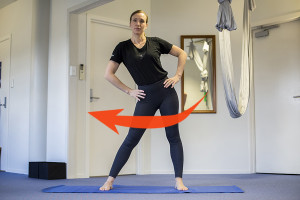
Standing hip rotations are a great example of a dynamic stretch.
Follow these directions for proper execution:
- Stand tall with the feet just wider than hip distance apart
- Rest hands on hips
- Put a slight bend in the knees
- Draw small circles with your hips, first clock-wise, then counter clockwise
- Don’t take the hips wider than the feet.
Now let’s check out the this movement in the AntiGravity® Hammock – a supportive device that allows our hips to have a wider circle of movement.

As the hammock takes the weight of the upper body, the hips can be allowed to circle wider without being under compression. It’s a gyroscopic movement that uses the hip’s full range of motion to gently warm up and release our middle body.
Static Stretching
This is a slow, gradual and controlled stretch performed AFTER exercise (don’t use this before warming up or before a strength routine as it could lead to injury and reduced performance)
Static stretching is excellent for lengthening muscles. Say if you are working towards the splits a controlled warm up, then time spent with static stretches will get you there quite quickly!
Take time at the end of training to wind down and stretch will quieten your heart beat and slow your mind – feel a huge sense of calm wash over you as all the feel-good hormones released from exercise come into play.
It’s a great place to take a bit of ‘me’ time!
Take your time and breath into stretches to get more length.
Here’s an example of a down dog, a great static stretch that lengthens the lower back and hamstrings, 2 key groups of muscles that can suffer from lack of stretching post – exercise.
Downward Facing Dog
An incredible all-body stretch for gentle static stretch.
(Please avoid down dog if you have any of the following: Carpel Tunnel Syndrome, Pregnancy, High Blood Pressure)
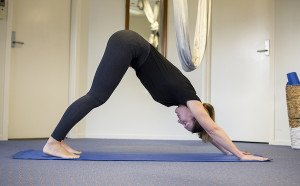
How to:
- Come down onto your mat on all fours, shoulders above wrists and hips in line with the knees.
- Wrist creases are parallel to the mat and fingers are wide and pointing forwards
- Tuck the toes and bring the bottom to the heels
- Lift the hips into a downwards facing dog, keeping knees bent
- Slowly pedal out the feet bringing the right heel down, then the left
- Back stays straight, so if the heels don’t reach the floor it’s okay! Work on stretching out the back
- Roll the upper arms out freeing the neck and the jaw
- Don’t forget to breath long and slow breaths
To take a break bend the knees – aim for 3 rounds of a few breaths each.
Downwards facing dog in the AntiGravity® hammock
The hammock almost acts like our own personal assistant, gently guiding the hips up and straightening the back.
The weight of the legs allows the backs of the legs to straighten minus pressure in the knees.
The hammock sits just under our hip points giving a lovely massage to our hip-flexors.
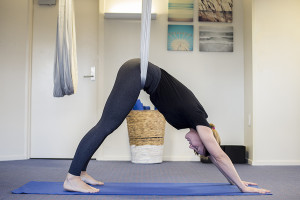
When should I stretch?
As a loose and general rule of thumb, dynamic stretches precede exercise and static stretches.
So basically stretching is best done after a warm-up.
Do you wake up stiff? A bit creaky?
Try leaping out of bed, doing dynamic stretching, then doing some gentle static stretches.
It will make a huge difference to your day and how you move for the rest of the morning.
In fact in an AntiGravity® class, we always begin with a variety of specific stretches and poses that flow together ensuring constant movement.
How long should I stretch for?
Ideally every day! (of course if you have any injuries please follow the advice of your health professional)
Before your workout, try dynamic stretches. A few rounds of 10 on each side should warm up the body nicely.
After working out, try holding a static the stretch 30-60 seconds. Don’t forget to breath!
(More on this in our next blog post )
What should it feel like?
Any stretch could feel uncomfortable at first. Try to stay though even if its just for a few seconds and you will start to feel a release.
Breath calmly and regularly through your nose and relax to the point of mild discomfort. Then you know you are getting a good stretch and reaping all the benefits we highlighted earlier!
Pain is never good; a stretch is often a balance between effort and relaxation.
Always be sure to progress slowly. If at any point you feel distress or pain, stop and seek medical advice.
What Next?
So now we know all the benefits of stretching and why adding a routine to your workout can bring your workout and performance to the next level!
We have learned some stretches we can do in the hammock and some stretches you can add to your workout to increase performance.
What stretches do you do to warm up and cool down before you train?
Let us know what your thoughts are, and if you have any questions on stretching and why it’s important, ask away!
Health and Happiness,
Freyja
This article was scientifically researched from various sources.
Written by Freyja from Float Fitness[/vc_column_text][/vc_column][/vc_row]
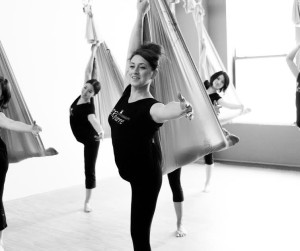 Why Does It Matter To Me?
Why Does It Matter To Me?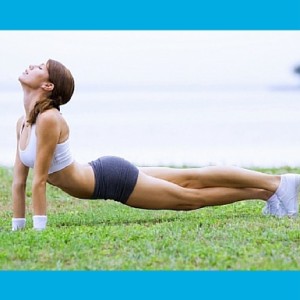 Flexibility and where it fits into your fitness goals
Flexibility and where it fits into your fitness goals